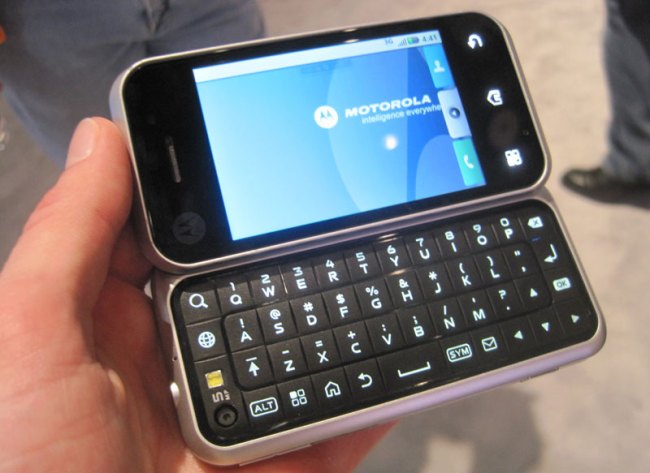
How sweet it is to finally have Motorola aboard the Android train. Although the company’s full line up has a ways to go, phones like the Cliq and Droid have gone a long way in restoring our faith, and the new Backflip looks to take yet another step.
On the surface, it’s a gimmick. Motorola could have just as easily produced a produced a horizontally sliding version of this phone and called it the Mini Cliq, because that’s about what it looks and feels like. But the keyboard, which is on the back of the phone when closed and swings around 180 degrees to typing position when open, adds a clever twist that will definitely add to the fashion appeal for this phone, similar to the way the strange rotation of the old Samsung Juke added to its appeal for wannabe switchblade owners.
We can’t say the same for the TrackBack feature – a stamp-sized trackpad on the rear of the screen that allows owners to make selections without touching the screen. We don’t like fingerprints anymore than the next red-blooded, greasy-handed American, but in practice the TrackBack proved too squirrely and unpredictable to actually use for smudge-less selecting. Give us a trackball any day.

On a bright note, build quality on this device seemed exceptionally high, right along the lines of the sturdy Cliq. For a device that’s going to do a lot of folding – and probably a few cringe-worthy drops to pavement when it’s fumbled – that’s important.
The keyboard, while large, could definitely take some getting used to, since it has only razor-like separation between keys and not too much depth to it. We also worry about durability, given that it faces outward in the closed position, but Motorola reps assured us it had been taken into consideration and tested thoroughly.
On the whole, we think the Backflip makes a truly promising Android device for smartphone buyers who want something smaller than the Cliq or Android, but without giving up a QWERTY keyboard. Stay tuned for a more thorough review when the device launches sometime in the first quarter.
Editors' Recommendations
- A new Motorola phone just leaked, and it could beat the Galaxy S24 Ultra
- The Motorola Edge 40 Pro is shaping up to be a Galaxy S23 Ultra killer
- Moto G 5G hands-on review: Good phone, better battery
- Motorola G Stylus 5G hands-on review: Notetaking nirvana on a budget
- Motorola Edge Plus (2022) hands-on review: Far from perfect


